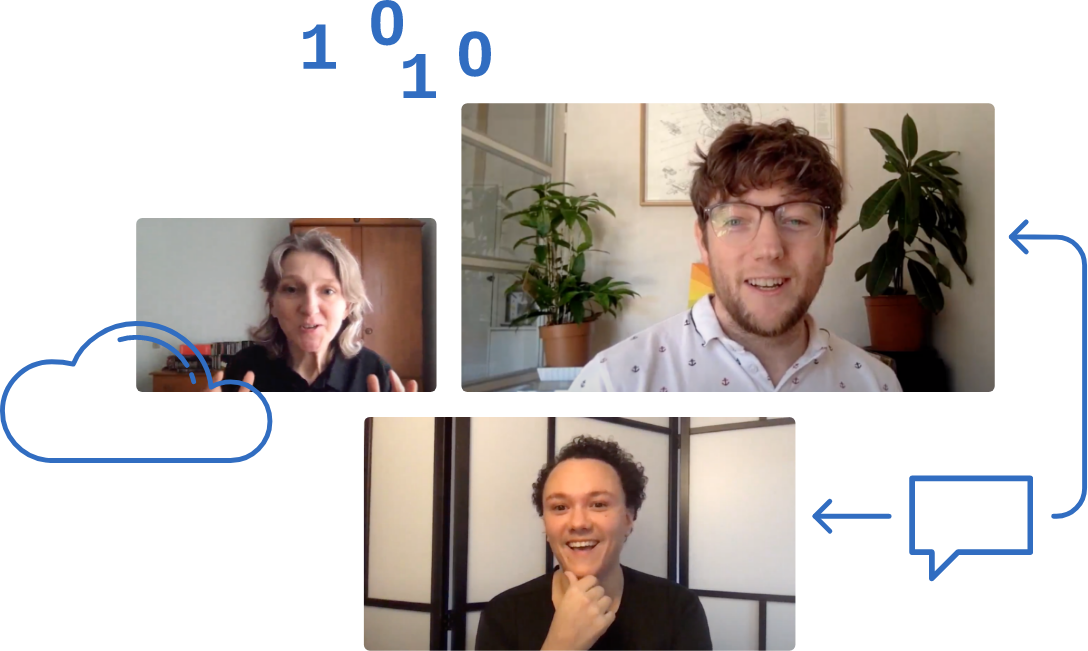Red Hat Blog Feature
World changing ideas: Red Hat Open Innovation Labs and the power of open source for good
It's no exaggeration to say that Red Hat sets out to change the world almost every day. (We take a day off now and again.) Even so, it's incredibly humbling and exciting to have Red Hat Open Innovation Labs recognized by Fast Company by being included in their 2021 World Changing Ideas awards.
Red Hat received honorable mentions in three 2021 World Changing Ideas awards categories, General Excellence, Developing-World Technology and Software.
Fast Company's General Excellence award celebrates "the broadest ideas" ranging from new governmental policies to new consumer categories, effecting change and solving problems are the criteria for this award. The Fast Company Developing World-Technology award is about helping the developing world and creating "leapfrog innovation."
Finally, the Software category is for those projects that are primarily in software, whatever the discipline may be. Red Hat is honored to have Open Innovation Labs recognized for its work by Fast Company, and we'd like to share the story of how we got there.
How we got there: A story of two teams
A startup of sorts...
We've always considered Red Hat Open Innovation Labs a place to experiment, a place to innovate, to learn the how and the why we do technology.
Red Hat's head of Open Innovation Labs, Mike Walker, describes it as a living, breathing work-in-progress customized to fit each customer and their specific technological needs.
A startup, of sorts, sitting inside the world's leading provider of enterprise open source software. We sought, and succeeded in, providing in-person, immersive, time-boxed residencies to organizations looking to learn how to build high-performing teams and new applications the Open Source Way. And then COVID-19 hit.
The teams that drove innovation, working shoulder-to-shoulder with customers and thriving on one another's energy, were sent to work from home. Video call after video call replaced the in-person camaraderie that helped fuel rapid-fire collaboration with customers.
This, to put it mildly, posed a challenge for the work we do with Open Innovation Labs where Red Hat had intentionally focused on face-to-face engagements. At the same time, healthcare organizations were seeing their own set of challenges arise as they took on the pandemic.
The World Health Organization (WHO), a specialized agency of the United Nations that is responsible for international public health, was on the front lines. It was struggling to get information out fast enough, to provide up-to-date guidance on dealing with COVID-19 as we continued to learn about the virus.
WHO realized that it needed to accelerate its digital capabilities on one of their key solutions, WHO’s Academy, to be able to provide up-to-date information to health workers around the world and improve the dissemination of the latest information to practitioners, policymakers and its own staff.
WHO’s office of Innovation accepted our invitation to collaborate with Red Hat’s Social Innovation Program, which works with nonprofits on key open source solutions that are helping solve the world’s most pressing problems. This is how WHO decided to collaborate in a Red Hat Open Innovation Labs virtual residency of eight weeks and in turn translate the power of open source software into real change for their key solution.
Consecutively, the Open Innovation Labs team had to innovate as well. Since the founding of Open Innovation Labs only five years ago, the team had focused on the immersive, in-person residency as its method of choice for working with organizations. With more than 110 engagements over those five years, the team had honed their skills at conducting residencies in person around the world to achieve measurable business results for its customers.
Eight Red Hatters joined eight people from WHO to collaborate on the WHO Academy application to speed up and improve WHO's ability to distribute information to health officials around the globe. After an eight-week engagement, they made great progress towards the tools and processes that are still being used today to build and improve the application.
Retooling for virtual innovation with trust and transparency
Bringing 16 people together from two different organizations spread across the globe is not an easy task.
Trust and transparency are key in order to have a successful collaboration and the Open Innovation Labs team remained focused on the human touch. They worked to make observations and corrections during the virtual engagement to learn what tools and practices worked best for this collaboration.
The Open Innovation Labs team drew on decades of lessons from open source development inside and outside Red Hat, where the larger FOSS community had been developing open source software through remote collaboration largely without the benefit of face-to-face interaction.
The key to it all was the shared commitment to open source software and open source ways of working. From the beginning, WHO was determined to build the platform using open source technology.
Aligned with WHO’s principles, open source enables cross-collaboration, accessibility and affordability, in particular for low- and middle-income countries. The agile development model helps the process become more nimble to attack problems from all sides at the same time, not one after another in the more traditional waterfall model.
Our ways of working are drawn from and inspired by proven practices in the Open Practice Library. Tailoring the practices to fit the needs of organizations to make disparate teams stronger, more connected and better positioned to speed innovation and iterate on their projects faster. The Open Innovation Labs team set the stage for informational transparency and collaboration by combining these practices with best-in-class video conferencing tools, interactive whiteboards and virtual canvases to enable as much collaboration as possible.
And there are advantages in the virtual process too. Something a virtual residency offers that in-person residencies do not is that sprint planning, daily standups, reviews, retrospectives, and other virtual sessions could be recorded and replayed to wider audiences within the organization to increase learning and adoption of practices.
"Working with Red Hat Open Innovation Labs provided a more flexible and responsive approach for creating solutions using open source technologies," says Bernardo Mariano, chief information officer and director, Digital Health, World Health Organization. "We were able to build a DevOps platform that can not only deliver relevant, timely COVID-related information and knowledge to health workers globally but one that can also scale and adapt to their future needs."
Sustainable open source infrastructure
Innovation is no longer a function of whether open source software is used, but what is used and how it is used.
Red Hat Open Innovation Labs helps organizations to move quickly and adopt agile methodologies that shorten development cycles.
Adding virtual residencies can not only benefit companies during times of crisis, but also beyond as global teams need to collaborate more often as a normal course of business.
"With the help of Red Hat Open Innovation Labs, the WHO broke down traditional IT barriers by replacing them with DevOps practices and solved challenges through collaboration, hard work and innovative thinking," says Hans Roth, senior vice president and general manager, Global Services, Red Hat.
In eight weeks, the WHO's virtual residency team produced a sustainable open source development infrastructure to support the development of the WHO’s Learning Experience Platform (LXP) for the WHO Academy, the organization’s new state-of-the-art training center.
Red Hat's technologies provide a reliable foundation
The new LXP will be run entirely on Red Hat’s open hybrid cloud technologies, offering WHO a scalable, flexible and more secure platform.
Red Hat OpenShift provides the cloud-native foundation, a streamlined environment for building and deploying containerized applications and capabilities for assessing application metrics. Red Hat CodeReady Workspaces is also being used to provide LXP developers a fast and reliable Kubernetes development foundation.
By basing LXP on an open technology framework, WHO is now better able to adopt emerging architectures and applications iteratively and incrementally, providing real-time value to global health workers. In addition, Red Hat OpenShift, as a cloud-agnostic Kubernetes platform, helps WHO to scale the LXP as demand grows without dependency on any particular cloud vendor.
While the platform has been designed with the COVID-19 crisis in mind, it will also be a scalable foundation for future challenges that require providing information quickly to global healthcare workers.
Five years of Red Hat Open Innovation Labs
The great experiment drives community-powered innovation
Red Hat launched Open Innovation Labs at OpenStack Summit in April 2016. Our goal? To help organizations integrate people, methodology and technology to solve business challenges in an accelerated fashion.
The strategy? Work collaboratively in a residency-oriented lab environment that brings Red Hat experts together with a team from the organization to rapidly develop and integrate applications using microservices, deploy them in containers, and deliver them using DevOps methodologies across physical, cloud and mobile environments that can quickly scale up or down on-demand.
With Open Innovation Labs, customers:
- Work on real business problems from day one.
- Learn how to take advantage of modern application development technologies and open source methodologies.
- Align cross-functional, high-performing teams to shared goals.
- Learn to be agile and adapt quickly to reshape solutions that solve specific problems.
- Develop skills that empower them to find the right mix of process and technology that works for them.
In five years, Red Hat has worked with a variety of organizations with more than 110 engagements, including Santander Tecnologia, Via Varejo, ANZ Bank, Unicef and many others.
We have not only focused on working with our customers, but on sharing our open practices and principles via the Open Practice Library. The community has developed 107 Product Lifecycle Practices from "Candy or Swag" to "Proto-Persona" to help define target users. The Open Practice Library can help any organization gain insights to incrementally improve team delivery of value along the product cycle. Get the "Transformation takes practice" e-book to help develop the tools and approaches that are right for you and your teams.
What started as a place to experiment has become an innovation engine, a way for Red Hat to help other organizations accelerate their innovation journey. We're amazed at what the past five years have held, and we're excited about the next five.
WHO transforms global health
with Red Hat Open Innovation Labs
The World Health Organization (WHO) faced an unprecedented challenge: build an online learning platform that turns valuable health information into high-impact educational resources. Scalability? Must serve millions of end-user health workers treating COVID-19 across the planet. The solution? A sustainable open source development infrastructure.
Their timeline? An eight-week virtual residency with Red Hat.



